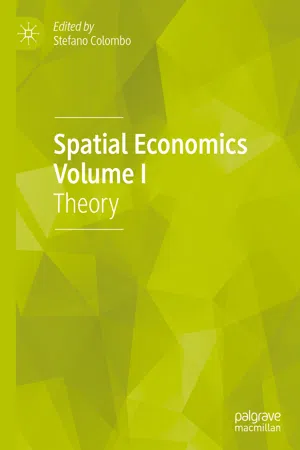1.1 Introduction
In this chapter, we illustrate some classic spatial models. Starting from the seminal paper of Hotelling (1929), space has become a crucial variable in the economic analysis of oligopolistic models.1 The aim of this chapter is mainly pedagogical: we aim to provide a useful collection of the principal classic spatial models, by illustrating their characteristics and the main results. Indeed, classic spatial models are a flexible tool which adopts the space dimension to model a wide array of economic questions, including industrial organization, regional science, and marketing. This is not an exhaustive review of spatial models. Indeed, hundreds and hundreds of spatial models have been developed by scholars; we have selectively chosen those contributions we believe represent the cornerstone of modern spatial economy, in order to provide a toolkit for those who are approaching this field for the first time.
Before starting, we briefly put forward the common characteristic of classic spatial models: classic spatial models do not want to represent “stylized facts”, but, rather, to highlight and describe the forces that determine the choices of the firms or the consumers. Indeed, classic spatial models are often too simple to provide a good description for what happens in the real word, but they are sufficiently simple to capture which incentives are at work when the firms or the consumers take their decision. This is the main purpose of classic spatial models.
The rest of the chapter proceeds as follows. In Sect. 1.2 we introduce and describe the linear model. In Sect. 1.3, we consider the circular model. In Sect. 1.4 we describe some spatial models adopting price discrimination, whereas in Sect. 1.5 we introduce elastic demand. In Sect. 1.6 we discuss the “barbell” model. In Sect. 1.7 we consider a spatial model of vertical differentiation. Section 1.8 concludes.
1.2 The Linear Model
In this section, we describe the linear model, which is based on the work of Hotelling (1929). The aim of the model consists in providing a simple framework to describe product differentiation, that is, a situation where a slight decrease of the price of one firm does not determine an abrupt increase of the demand of that firm, but rather a gradual shift of demand. In fact, Hotelling was rather skeptical about Bertrand’s (1883) criticism of Cournot (1838) equilibrium. Indeed, “in all [Bertrand’s] illustrations of competition one merchant can take away his rival’s entire business by undercutting his price ever so slightly. This discontinuities appear, though a discontinuity, like a vacuum, is abhorred by nature. More typical of real situations is the case in which the quantity sold by each merchant is a continuous function of two variables. His own price and his competitor’s. Quite commonly a tiny increase in price by one seller will send only a few customers to the other” (Hotelling 1929, p. 44). Therefore, the linear model originates in order to show that price competition does not necessarily lead to the perfect competition outcome (the so-called Bertrand paradox). Intuitively, this happens because, once space is introduced, product differentiation arises, and this allows avoiding the Bertrand paradox. Nowadays, the linear (Hotelling) model is the most widely used model to describe oligopolistic competition between firms selling non-homogenous products.
Suppose there is a continuum of consumers located along a segment of length 1, from 0 to 1. The segment might have a “spatial” interpretation or a “product differentiation” interpretation. In the first case, the location of a consumer or a firm in the segment refers to the location in a strict physical sense (i.e., the consumer or the firm is really located at a certain point). In the second case,...
